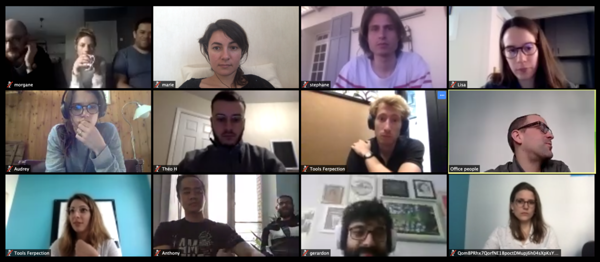May 14, 2019
What does it mean to work 100% remotely at Ferpection?
With a quarter of our team working remotely full time and the others who can choose to work remotely whenever they wish, we can say that working remotely is part of our culture. But what is remote work really like at Ferpection?
As a developer, I work entirely remotely (or "in full remote"). I will try to add to this article my own experiences as well as those of my fellow designers, user research experts and others who are also working remotely.
Why does Ferpection rely on remote working?
Ferpection always places people first in every decision. This is why we always take our users and their opinions into account, but also our employees and their personal well-being. We truly believe that this will lead us to offer the best products for our customers and partners.
To this end, we want to leave it up to our employees to decide the environment in which they feel best to work. Remote working greatly addresses this issue. A team member thinks that he will now work better from home? Then, we want him to stay home. Does he rather think he will be better at the office with his colleagues? In this case we think he should come and stay with us. Or perhaps he will be more productive in the quiet atmosphere of a library, in a park or in a cafe? The employee has the freedom to choose what is best for him according to his work.
How is remote work organized?
Naturally, remote working comes with its share of difficulties such as remote meetings, team synchronization across multiple time zones, schedule management, etc.
Schedule management
At Ferpection all employees can work remotely if and when they wish. Consequently, there are never the same people on our premises.
"Remote working at Ferpection means working at Station F on Mondays and beside my chickens the next day." - Marie, Product Designer
If you want or need to work with someone specific, the best solution is video calling. But you may want to work together in person. How to do this?
In our company, a bot asks us every day who will be physically present in the office the next day. Everyone then votes by adding a reaction to the bot's message
Remote meetings
We have certainly learned a lot on the subject and are still learning a lot at each meeting. We no longer organize meetings as we first did.
One of the major challenges in meetings involving remote workers is ensuring inclusion. Indeed, we have regular meetings in the following set-up:
-
several employees in one place
-
employees alone at their place
This is a classic setting. What will naturally happen if we're not careful is that people in the same location will prefer to talk to each other rather than use the video messaging software. As a result, they pay less attention to what is happening on the other side of the call and remote employees are excluded from the discussion. The latter will have less ability to hear and understand what is being said and therefore will be less likely to participate in the meeting.
To overcome this problem, we decided to ask all participants to use their computers for meetings even if several of them are in the same room. This way we put everybody in the same situation (that of the remote workers), nobody is excluded from the discussion and the meeting is much more helpful and constructive for everyone.
Working across time zones
A large part of our employees work in Paris, but some are also in Lyon, Brazil, Canada or virtually anywhere in the world since they can work remotely. On the other hand, our teams are not organized by location but by skills (or by a shared desire to work on a specific task), which means that our employees often work with colleagues on the other side of the world.
In this configuration, working with several people can become complicated, but with a strong sense of communication and good will, anything is possible. For this reason, we use automation and tools designed for these cases to encourage and help our collaborators.
Our internal messaging tool takes into account the individual needs of each employee and informs others of these needs. For example, if you try to send a message to employees scattered across the globe you may receive a message like this one: "Your message will be sent to 7 people in 4 different time zones. Some of your colleagues may not see it. Do you wish to continue?"
The software also notifies you if the recipient of the message is not expected to work for whatever reason (vacation, nighttime, etc.). This way you know that he or she will not be notified for this message and that he or she will answer only when logging on again.
We also use a lot of automation. We have a bot that creates a conversation in the messaging tool every day. In this conversation, he asks our product team to indicate what each person plans to do during the day. This way, other developers/designers/collaborators can offer their help if they are interested in the task or provide useful information to the person who will be working on the task.
Therefore, we use the tools to encourage people to communicate. But we also don't want to communicate too much information or communicate ineptly.
Remote worker's guilt
The objective of working remotely at Ferpection is to make our employees happy to work with us. We would like to emphasize the fact that a happy employee is a productive, creative, innovative, committed employee, and with many other interesting qualities from a human point of view and for the company.
Unfortunately, remote work also has its drawbacks, which we want to avoid. Studies show that remote workers feel a greater need to prove that they are actually working. This leads them to be too reactive on the company's internal messaging system, to receive too many notifications from all the communication tools we use. As a result, they are stressed, they are much less efficient in their work or are forced to work overtime when their colleagues are not connected in order to catch up.
To avoid this, our culture acts as a shield. We don't want our remote employees to feel undue stress and guilt. Therefore, each employee has his part to play: be considerate, tolerant and understanding, and communicate his needs clearly (even if it means expressly stating that a request is not at all urgent).
"Employees should be encouraged not to feel guilty. The founders and first employees must set an example because they are the ultimate indicator of the practices." - Gregoire, COO
As for the previous examples, our corporate culture encourages us to implement certain tools.
Our messaging tool does not indicate whether the correspondent is connected or has read the message. This way he doesn't feel obligated to read and reply to messages immediately. He can manage his time to best suit his schedule and workload. We really try to create a trusting, healthy atmosphere between remote and on-site workers.
And finally, I would like you to take a look at Gerardo, our backend developer based in Belo Horizonte (Brazil), who shares with us what Ferpection's culture brings him as a remote worker.
Visit our "about us" page to learn more about remote work, the liberated company and our teams.All articles from the category: Culture | RSS

